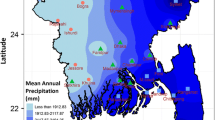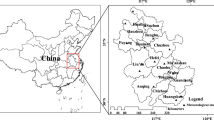Abstract
Joint probability behavior of droughts is important for China due to the fact that China is the agricultural country with the largest population in the world and it is particularly the case in the backdrop of intensifying weather extremes in a warming climate. In this case, regionalization of droughts is done using Fuzzy C- Means (FCM) clustering technique and also multivariate L-moment method. Besides, copula is used to estimate regional joint probability in terms of drought duration and severity. Evaluation of uncertainty in the joint probability curves is done using the Bootstrap resampling technique. The results indicate that: (1) five homogenous regions of droughts are subdivided. Regionalization in this study clarified the changing properties or nature of droughts, i.e., the blurred or ambiguous boundaries of the drought-impacted regions; (2) droughts in the northwest China are characterized by longer drought duration and larger drought severity, and the occurrence of the droughts in the northwest China is subject to be higher due to longer waiting time between drought events. Adverse is found for changes of droughts in the southeast China. The droughts in the north China are moderate in terms of drought duration and severity and also waiting time between drought events when compared to those in the northwest and southeast China; (3) the regional joint frequency curves are obtained with respect to drought duration and severity using the bivariate copula functions. Then the joint probabilities of droughts can be calculated using the regional probability curves and also results of mean drought duration, drought severity and waiting time between drought events. Furthermore, droughts in the regions without meteorological data can also be estimated in terms of joint probability using index-drought method proposed in this study. This study will provides theoretical and practical grounds for development and enhancement of human mitigation to drought hazards in China, and is of great importance in terms of planning and management of water resources and agricultural activities in the backdrop of intensifying weather extremes under the influences of warming climate.








Similar content being viewed by others

References
Allen RG, Pereira LS, Raes D, Smith M (1998) Crop evapotranspiration: guidelines for computing crop requirements, irrigation and drainage paper 56. FAO, Roma
Asquith WH (2011) lmomco-L-moments, trimmed L-moments, L-comoments, censored L-moments, and many distributions. R package version 1.3.6, http://www.cran.r-project.org/package=lmomco, Texas Tech University, Lubbock, Texas
Bazrafshan J, Hejabi S, Rahimi J (2014) Drought monitoring using the multivariate standardized precipitation index (MSPI). Water Resour Manag 28(4):1045–1060
Bezdek JC (1980) A convergence theorem for the fuzzy ISODATA clustering algorithm. IEEE Trans Pattern Anal Mach Intell 2(1):1–8
Burn DH (2003) The use of resampling for estimating confidence intervals for single site and pooled frequency analysis. Hydrol Sci J 48(1):25–38
Chebana F, Ouarda T (2007) Multivariate L-moment homogeneity test. Water Resour Res 43(8), W08406
Dalrymple T (1960) Flood frequency analysis, US Geol. Surv Water Supply Paper 1543A:11–51
Dunn JC (1974) A fuzzy relative of the ISODATA process and its use in detecting compact, well-separated clusters. J Cybern 3(3):32–57
Ganguli P, Reddy JM (2014) Evaluation of trends and multivariate frequency analysis of droughts in three meteorological subdivisions of western India. Int J Climatol 34:911–928
Genest C, Rémillard BD (2009) Goodness-of-fit tests for copulas: a review and a power study. Insur: Math Econ 44:199–213
Hailegeorgis TT, Thorolfsson ST, Alfredsen K (2013) Regional frequency analysis of extreme precipitation with consideration of uncertainties to update IDF curves for the city of Trondheim. J Hydrol 498:305–318
Hao Z, AghaKouchak A (2013) Multivariate standardized drought index: a parametric multi-index model. Adv Water Resour 57:12–18
Heim Richard R (2002) A review of twentieth-century drought indices used in the United States. Bull Am Meteorol Soc 83:1149–1165
Hosking JRM (1990) L-moments: analysis and estimation of distributions using linear combinations of order statistics. J R Stat Soc 52(1):105–124
Hosking JRM, Wallis JR (1997) Regional frequency analysis: an approach based on L-moments. Cambridge University Press, Cambridge
Kao S-C, Govindaraju RS (2010) A copula-based joint deficit index for droughts. J Hydrol 380:121–134
Kendall MG (1995) Rank correlation methods. Griffin, London
Mann HB (1945) Nonparametric tests against trend. Econometrica 13(3):245–259
Martins ES, Stedinger JR (2002) Cross correlations among estimators of shape. Water Resour Res 38(11):1252. doi:10.1029/2002WR001589
Mathier L, Perreault L, Bobe B, Ashkar F (1992) The use of geometric and gamma-related distributions for frequency analysis of water deficit. Stoch Hydrol Hydraul 6(4):239–254
McEvoy DJ, Huntington JL, Abatzoglou JT, Edwards LM (2012) An evaluation of multiscalar drought indices in Nevada and Eastern California. Earth Interact 16(18):1–18
Mishra KA, Singh PV (2010) A review of drought concepts. J Hydrol 391:202–216
Nelsen RB (2006) An introduction to copulas. Springer, Verlag
Palmer WC (1965) Meteorological drought. U.S. Department of Commerce Weather Bureau Research Paper, 45, 58 pp
Potop V, Boroneanţ C, Možný M, Štĕpánek P, Skalák P (2014) Observed spatiotemporal characteristics of drought on various time scales over the Czech Republic. Theor Appl Climatol 115:563–581
Rao AR, Srinivasb VV (2006) Regionalization of watersheds by fuzzy cluster analysis. J Hydrol 318:57–79
Rossi G (2009) European Union policy for improving drought preparedness and mitigation. Water Int 34(4):441–450
Rossi G, Cancelliere A (2013) Managing drought risk in water supply systems in Europe: a review. Int J Water Resour Dev 29(2):272–289
Ruspini EH (1969) A new approach to clustering. Inf Control 15(1):22–32
Sadri S, Burn DH (2011) A Fuzzy C-Means approach for regionalization using a bivariate homogeneity and discordancy approach. J Hydrol 401:231–239
Satyanarayana P, Srinivas VV (2011) Regionalization of precipitation in data sparse areas using large scale atmospheric variables - A fuzzy clustering approach. J Hydrol 405:462–473
Serfling R, Xiao P (2007) A contribution to multivariate L-moments: L-comoment matrices. J Multivar Anal 98(9):1765–1781
Shiau JT, Feng S, Nadarajah S (2007) Assessment of hydrological droughts for the Yellow River, China, using copulas. Hydrol Process 21:2157–2163
Sklar A (1959) Fonctions de répartition àn dimensions et leurs marges. Publ Inst Stat Univ Paris 8:229–231
Spinoni J, Antofie T, Barbosa P, Bihari Z, Lakatos M, Szalai S, Szentimrey T, Vogt J (2013) An overview of drought events in the Carpathian Region in 1961–2010. Adv Sci Res 10:21–32
Srinivas VV, Tripathi S, Rao AR, Govindaraju RS (2008) Regional flood frequency analysis by combined self-organizing feature map and fuzzy clustering. J Hydrol 348:148–166
Tsakiris G, Pangalou D, Vangelis H (2007) Regional drought assessment based on the Reconnaissance Drought Index (RDI). Water Resour Manag 21(5):821–833
Tsakiris G, Nalbantis I, Vangelis H, Verbeiren B, Huysmans M, Tychon B, Jacquemin I, Canters F, Vanderhaegen S, Engelen G, Poelmans L, de Becker P, Batelaan O (2013) A system-based paradigm of drought analysis for operational management. Water Resour Manag 27(15):5281–5297
Vicente-Serrano SM, Beguería S, López-Moreno JI (2010) A multiscalar drought index sensitive to global warming: the standardized precipitation evapotranspiration index. J Clim 23:1696–1718
Vicente-Serrano SM, Beguería S, Lorenzo-Lacruz J, Camarero JJ, López-Moreno JI, Azorin-Molina C, Revuelto J, Morań-Tejeda E, Sanchez-Lorenzo A (2012a) Performance of drought indices for ecological, agricultural, and hydrological applications. Earth Interact 16(10):1–27
Vicente-Serrano SM, López-Moreno JI, Beguería S, Lorenzo-Lacruz J, Azorin-Molina C, Morán-Tejeda E (2012b) Accurate computation of a streamflow drought index. J Hydrol Eng 17:318–332
Vicente-Serrano SM, JI Lopez-Moreno, S Beguería, J Lorenzo-Lacruz, A Sanchez-Lorenzo, JM García-Ruiz, C Azorin-Molina, E Morán-Tejeda, J Revuelto, R Trigo, F Coelho and F Espejo (2014) Evidence of increasing drought severity caused by temperature rise in southern Europe. Environ. Res. Lett. 9:044001(9pp), doi:10.1088/1748-9326/9/4/044001
Wilhite DA (1993) Drought assessment, management and planning: theory and case studies. Kluwer, 293 pp
Wilhite DA and M Buchanan-Smith (2005) Drought as hazard: Understanding the natural and social context. Drought and Water Crises: Science, Technology, and Management Issues, D. A. Wilhite, Ed., CRC Press, 3–29
Xie XL, Beni G (1991) A validity measure for fuzzy clustering. IEEE Trans Pattern Anal Mach Intell 13(8):841–847
Yang T, Shao Q, Hao Z-C, Chen X, Zhang Z, Xu C-Y, Sun L (2010) Regional frequency analysis and spatio-temporal pattern characterization of rainfall extremes in the Pearl River Basin, China. J Hydrol 380:386–405
Yusof F, Hui-Mean F, Suhaila J, Yusof Z (2013) Characterisation of drought properties with bivariate copula analysis. Water Resour Manag 27(12):4183–4207
Zelenhastic E, Salvai A (1987) A method of streamflow drought analysis. Water Resour Res 23(1):156–168
Zhang L, Singh VP (2007) Bivariate rainfall frequency distributions using Archimedean copulas. J Hydrol 332:93–109
Zhang Q, Singh VP, Li J, Chen X (2011) Analysis of the periods of maximum consecutive wet days in China. J Geophys Res 116, D23106. doi:10.1029/2011JD016088
Zhang Q, VP Singh, M Xiao, J Li (2012) Regionalization and spatial changing properties of droughts across the Pearl River basin, China. Journal of Hydrology 472–473:355–366
Zhang Q, Xiao M, Singh VP, Chen X (2013) Copula-based risk evaluation of droughts across the Pearl River basin, China. Theor Appl Climatol 111(1):119–131
Zhang Q, Sun P, Li J, Singh VP, Liu J (2014) Spatiotemporal properties of droughts and related impacts on agriculture in Xinjiang, China. Int J Climatol. doi:10.1002/joc.4052
Acknowledgments
This work is financially supported by the National Science Foundation for Distinguished Young Scholars of China (Grant No.: 51425903), the Xinjiang Science and Technology Planning Project (Grant No.: 201331104), the Leading Expert Project by Anhui Province and fully supported by a grant from the Research Grants Council of the Hong Kong Special Administrative Region, China (Project No. CUHK441313). Our cordial gratitude should be extended to the editor-in-chief, Prof. Dr. George P. Tsakiris, and three anonymous reviewers for their careful and insightful review and also for their pertinent and relevant comments and suggestions which are greatly helpful for further improvement of the quality of this manuscript.
Author information
Authors and Affiliations
Corresponding author
Rights and permissions
About this article
Cite this article
Zhang, Q., Qi, T., Singh, V.P. et al. Regional Frequency Analysis of Droughts in China: A Multivariate Perspective. Water Resour Manage 29, 1767–1787 (2015). https://doi.org/10.1007/s11269-014-0910-x
Received:
Accepted:
Published:
Issue Date:
DOI: https://doi.org/10.1007/s11269-014-0910-x



